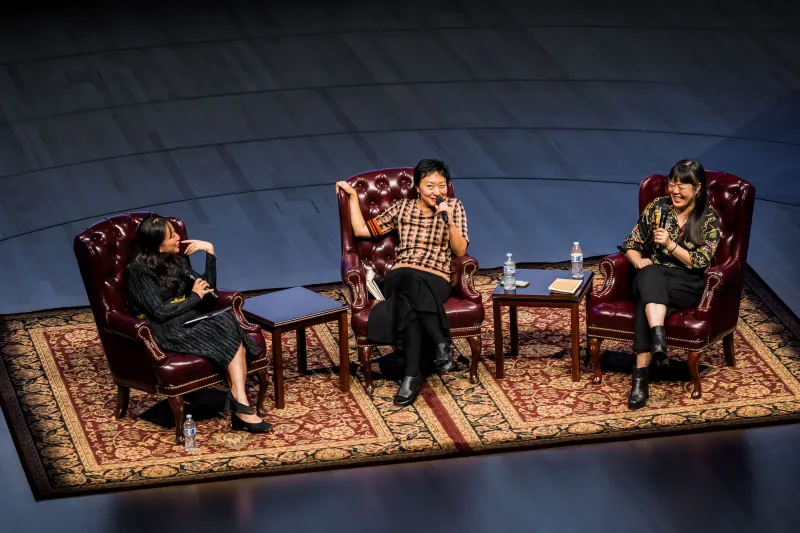What happens when private intimacies are brought into the public sphere? How can the luminosity of personal connections between artists be captured when later generations dig into the archive? Poet Cathy Park Hong and artist Jen Liu’s conversation during the keynote event of the Asian American Art Initiative’s IMU UR2 symposium brings these questions to the forefront. AAAI constructs an archive of Asian American art, from exhibiting the work of living artists, to spotlighting other archives, to putting art historians in conversation with each other. Under this framing, Hong and Liu’s conversation serves as an archival process — they center female friendships between people of color in the archive.
Hong notes, tongue-in-cheek, that it felt like her friendship with Liu was “going public” and “being historicized” through this conversation, pointing towards her consciousness of their personal memories being inducted into an archive. Hong teases out both the awkwardness of shining a light on private moments and the generative possibilities of intimate connections for pondering questions of Asian American identity and art.
The conversation on Saturday night, moderated by Stanford art and art history professor and AAAI co-director Marci Kwon, centered female friendships in a history of discourse that often primarily mythologized male friendships. After meeting at art camp, Hong and Liu also attended Oberlin College together in the 1990s. Liu appears in “Minor Feelings” as the figure of Erin, a baddie whom the protagonist thought was too cool to want to be friends with her. As Hong read from a passage about first meeting Erin at art camp from the book, Liu lovingly insisted that she wanted to be friends with Hong first!
“In college, the most intense, hot-house, romantic relationship is with your friends,” Hong reflected. She noted that movements, innovations and manifestos were all often created in offline relationships outside of the classroom. This observation situates the potential for imagining futurities in the intimate moments between people.
These intimacies are also often highly charged and multi-valent, crossing the heteronormative distinction of friendship and romance. “One of the brutalities of heteronormativity is to silo intimacy. Our friendship couldn’t survive in that compartmentalization,” Liu emphasized.
Hong and Liu borrowed the term “luminosity” when thinking about Asian American communities and, specifically, female affinities. “Luminosity” was proposed by Patrick Flores, professor at the University of the Philippines, at the IMU UR2 symposium earlier in the day to describe a form of Asian American ontology. Hong and Liu reflected on Theresa Hak Kyung Cha’s autobiographical work “Dictée” as luminous in its moments of silence and allowance for the unspoken. “It’s okay to be ineloquent; you can use that ineloquence in your poetry,” Hong explained.
Also luminous is Hong’s notion of “jeong” as an immediate kinship between people that rests on unspoken mutual understandings. A crucial aspect of the “jeong” between people of color is the comfort of not having to explain anything to the white gaze. Teasing out central ideas from Hong and Liu’s conversation and building off of them, Kwon elaborates on this state of not having to explain as artists’ mutual basis for creativity. This formulation prompts an understanding of luminous kinships between Asian American artists as origins for future work.
It seems coldly academic to frame Saturday’s conversation as an archiving of Asian American female friendships. The charm of Hong and Liu’s exchanges highlights the necessity of the archive to preserve the luminosity of a shared moment between people without ossifying its luminescence into the glossy, placid surface of a photograph.
When Hong and Liu attended college together, they were amidst a wave of cultural awakenings. In Hong’s words, “Oberlin was woke before everyone was woke.” Hong and Liu recollected the mentorship that they received from faculty of color, which they later realized was exceptional at the time. Hong talked at length about the transformative power of a poetry class she took with Myung Mi Kim, who instilled in her early on the realization that “art was political and is political.”
The conversation was filled with memories of the artists’ college days, yet Hong and Liu did not sink into sentimental nostalgia about those years. Liu emphasized that Oberlin was not a utopia, but a flawed place where she and her friends articulated resistance through experimental art forms. Liu summarized the 90s as a time during which a “toxic multiculturalism” that was interpreted through the white voice and the white gaze thrived. Despite there being people of color in positions of power, Hong nonetheless felt that the presence of her, Liu and another friend was perceived as a threat in an otherwise all-white English department. Ambitious and refusing to submit to others’ definitions of them, they were, in Liu’s words, “more than slightly hypercritical” of the institution.
When asked about navigating the relationship between art and activism, Liu warned against falling into easy binaries. She urged the audience to attend to their needs as both artists and activists. Hong recognized the seduction of cynicism but encouraged the audience not to sink into it. “I’m tired, but we can’t be tired. I want to take a break, but don’t take a break for too long,” she said about creating art in our current political climate.
